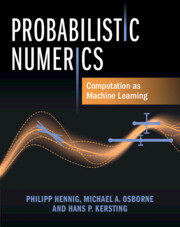Refine search
Actions for selected content:
2540 results in Computational Science
Appendix C - The NVCC Compiler
-
- Book:
- Programming in Parallel with CUDA
- Published online:
- 04 May 2022
- Print publication:
- 02 June 2022, pp 387-392
-
- Chapter
- Export citation
Contents
-
- Book:
- Programming in Parallel with CUDA
- Published online:
- 04 May 2022
- Print publication:
- 02 June 2022, pp vii-ix
-
- Chapter
- Export citation
Preface
-
- Book:
- Programming in Parallel with CUDA
- Published online:
- 04 May 2022
- Print publication:
- 02 June 2022, pp xix-xxii
-
- Chapter
- Export citation
9 - Scaling Up
-
- Book:
- Programming in Parallel with CUDA
- Published online:
- 04 May 2022
- Print publication:
- 02 June 2022, pp 293-324
-
- Chapter
- Export citation
1 - Introduction to GPU Kernels and Hardware
-
- Book:
- Programming in Parallel with CUDA
- Published online:
- 04 May 2022
- Print publication:
- 02 June 2022, pp 1-21
-
- Chapter
-
- You have access
- Export citation
7 - Concurrency Using CUDA Streams and Events
-
- Book:
- Programming in Parallel with CUDA
- Published online:
- 04 May 2022
- Print publication:
- 02 June 2022, pp 209-238
-
- Chapter
- Export citation
Appendix B - Atomic Operations
-
- Book:
- Programming in Parallel with CUDA
- Published online:
- 04 May 2022
- Print publication:
- 02 June 2022, pp 382-386
-
- Chapter
- Export citation
11 - Tensor Cores
-
- Book:
- Programming in Parallel with CUDA
- Published online:
- 04 May 2022
- Print publication:
- 02 June 2022, pp 358-372
-
- Chapter
- Export citation
6 - Monte Carlo Applications
-
- Book:
- Programming in Parallel with CUDA
- Published online:
- 04 May 2022
- Print publication:
- 02 June 2022, pp 178-208
-
- Chapter
- Export citation
4 - Parallel Stencils
-
- Book:
- Programming in Parallel with CUDA
- Published online:
- 04 May 2022
- Print publication:
- 02 June 2022, pp 106-141
-
- Chapter
- Export citation
Examples
-
- Book:
- Programming in Parallel with CUDA
- Published online:
- 04 May 2022
- Print publication:
- 02 June 2022, pp xv-xviii
-
- Chapter
- Export citation
Figures
-
- Book:
- Programming in Parallel with CUDA
- Published online:
- 04 May 2022
- Print publication:
- 02 June 2022, pp x-xii
-
- Chapter
- Export citation
Index
-
- Book:
- Programming in Parallel with CUDA
- Published online:
- 04 May 2022
- Print publication:
- 02 June 2022, pp 448-454
-
- Chapter
- Export citation

Probabilistic Numerics
- Computation as Machine Learning
-
- Published online:
- 01 June 2022
- Print publication:
- 30 June 2022
12 - Reduced-Order Models (ROMs)
- from Part IV - Advanced Data-Driven Modeling and Control
-
- Book:
- Data-Driven Science and Engineering
- Published online:
- 10 June 2022
- Print publication:
- 05 May 2022, pp 449-484
-
- Chapter
- Export citation
Contents
-
- Book:
- Data-Driven Science and Engineering
- Published online:
- 10 June 2022
- Print publication:
- 05 May 2022, pp v-viii
-
- Chapter
- Export citation
14 - Concluding Remarks
- from Part III - Further Properties of Hybrid Iterative Algorithms and Suggestions for Improvement
-
- Book:
- Geometry of the Phase Retrieval Problem
- Published online:
- 21 April 2022
- Print publication:
- 05 May 2022, pp 292-296
-
- Chapter
- Export citation
Index
-
- Book:
- Geometry of the Phase Retrieval Problem
- Published online:
- 21 April 2022
- Print publication:
- 05 May 2022, pp 263-308
-
- Chapter
- Export citation
Index
-
- Book:
- Data-Driven Science and Engineering
- Published online:
- 10 June 2022
- Print publication:
- 05 May 2022, pp 588-590
-
- Chapter
- Export citation
5 - Clustering and Classification
- from Part II - Machine Learning and Data Analysis
-
- Book:
- Data-Driven Science and Engineering
- Published online:
- 10 June 2022
- Print publication:
- 05 May 2022, pp 168-207
-
- Chapter
- Export citation
